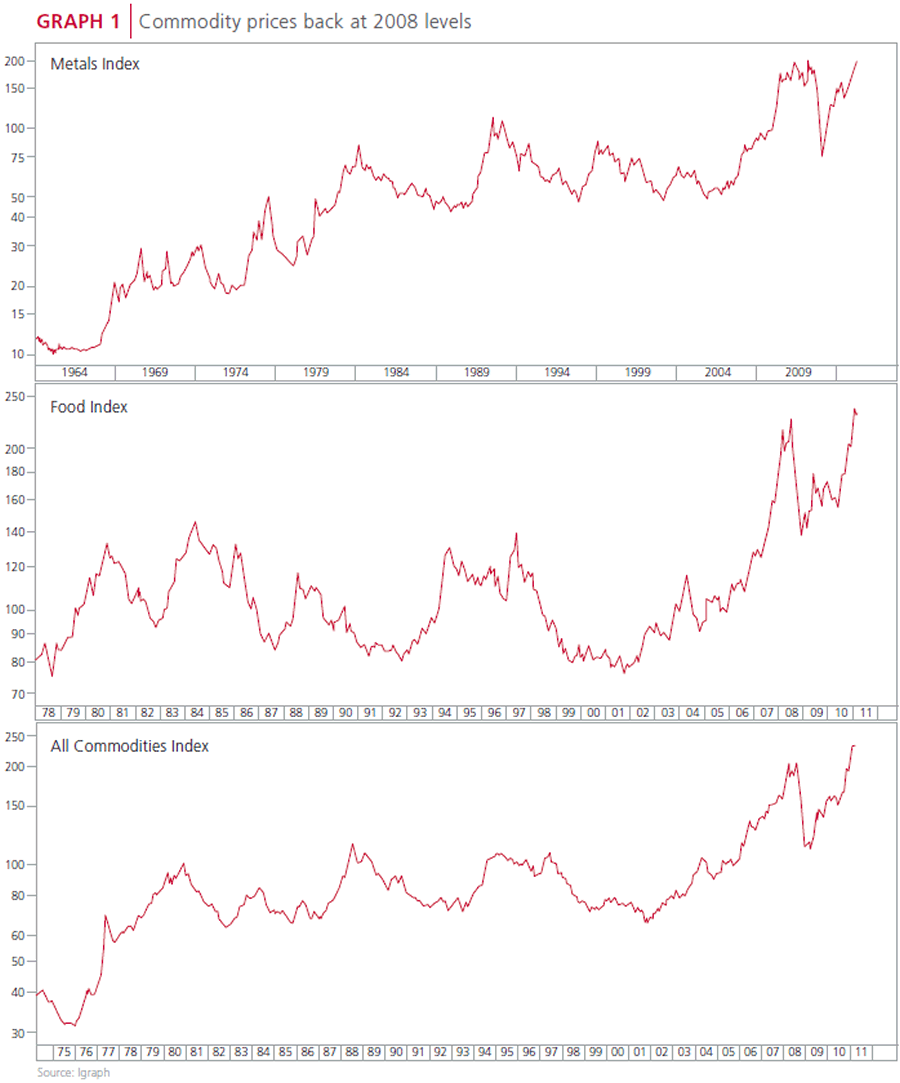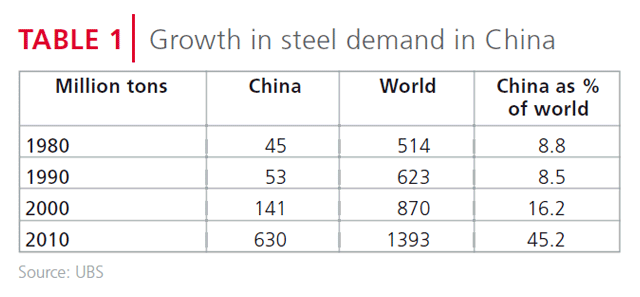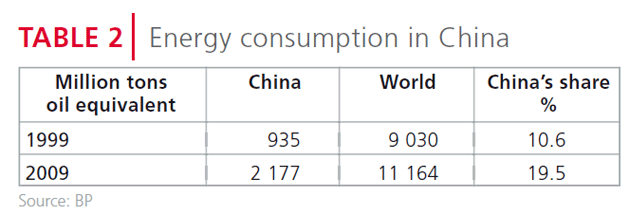Two years since the global financial crisis and commodity prices are back at the record levels of June 2008. This growth has been about five years quicker than in previous recessions. What makes the present cycle so different is the impact of China, which responded to the economic crisis by accelerating capital expenditure, leading to a surge in demand for energy and raw materials. The question is, can the world keep pace with the growing demand? Sandy McGregor investigates.
The recovery from the recession triggered by the Lehman failure in September 2008 has generally followed a path typical of previous recessions. An exception has been the behaviour of commodities as can be seen in Graph 1. In previous cycles it typically took about seven years for prices to return to their old highs. This time, after only two years, prices are back at the record levels of June 2008. Clearly we are witnessing something unprecedented.
What makes the present cycle so different from all the previous ones, is the impact of China. We are witnessing a surge in economic growth in China similar to that experienced by Germany after World War II, Japan between 1960 and 1980 and the Asian Tigers (Korea, Taiwan, Singapore) in the 1980s. What makes China different is its scale. It is the third largest country after Russia and Canada with an area of 9.3m square kilometres. Physically, it is slightly larger than the United States. It is the country with the largest population (1.33 billion). In contrast, other regions that industrialised rapidly are much smaller. Western Europe's population is 395 million and Japan's is 127 million. China aspires to a living standard similar to that of Japan and Europe. To achieve this, it must create an economy three times the size of Western Europe or 10 times the size of Japan.
Surge in demand for raw materials and energy
The early stages of the development cycle are extremely material intensive. The consumption of raw materials is one of the best measures of the progress China is making in achieving its goals. For example, consider steel consumption. Since Deng Xiaping's economic reforms in 1980 created a market economy, China's steel demand has grown tremendously, as illustrated in Table 1. Note the acceleration in the growth in demand over the past decade.
Another good metric is energy. China has now overtaken the US as the world's largest energy consumer. About 70% of its energy requirements are met by domestic coal production. Aggregating all energy consumption as an oil equivalent, Table 2 shows how China's energy demands have more than doubled since 1999.
China responded to the recent world economic crisis by accelerating capital expenditure. This is why commodity prices have behaved so atypically in comparison with previous cycles. During the downturn, demand in the biggest consumer of raw materials grew rather than contracted.
THE QUESTION BEING ASKED IS, DOES THE WORLD HAVE THE RESOURCES AND CAPACITY TO PRODUCE FOOD TO MEET THE GROWING DEMAND FROM ALMOST ONE-THIRD OF THE WORLD'S POPULATION
Prior to 2003 the mining industry was structured to expand at about 3% annually to meet the growth in global requirements. The sudden addition of China to the equation has roughly doubled demand growth. Commodity producers are struggling to meet these demands and prices have appreciated accordingly.

Can the world keep pace with the growing demand?
The concept of a resource constraint to growth is not new. The most famous proponent of the idea that food would ultimately act as a limit to growth, was Thomas Malthus (1766-1834). He argued that the population would grow inexorably, but there was a limit to potential food production because arable land is finite. Ultimately the competition for food would make the world a miserable place, subject to famines and wars. Malthus's views were rapidly discredited. The world has been able to produce as much food as it needs, due to technology.
Malthus's ideas had a revival in 1972 when the Club of Rome, a think tank of economists and experts founded by the Italian Aurelio Peccei in 1968, warned that there were limits to growth due to a shortage of energy and raw materials.
Its report entitled 'Limits to Growth' made the institution famous and for some years, during the 1970s, high prices of oil, metals and grains suggested that it might have a case. However, in time the market economy made adjustments which eliminated shortages and set the world on a growth path that lasted over 25 years. There is an old adage that high prices fix high prices and low prices fix low prices. High prices encourage production and discourage consumption by making people more efficient. Certainly in the aftermath of the 1970s this proved to be the case and the Club of Rome's predictions were discredited. However, with the advent of China and increasingly also India as the principal consumers of resources, the question being asked is, does the world have the resources and capacity to produce food to meet the growing demand from almost one-third of the world's population? The Malthusian argument is back.
One particular concern is strained water resources, especially in China. To sustain economic growth China will have to greatly expand desalination of sea water so that it can supply its major northern cities such as Beijing and Shanghai with fresh water. Fortunately desalination technology is improving all the time. As long as water is priced to make desalination viable there should be adequate water over time to support large conurbations. However, the investment required will be huge. Agricultural water resource may be a bigger challenge and strikes at the heart of the issue of food security. These problems can be solved but will require considerable commitment and take time.
The world has sufficient energy resources should it choose to develop coal and nuclear power to their full potential. The advent of shale gas may have brought some respite creating a temporary energy surplus. Shale gas is a good example of how a change in technology can profoundly affect prices. However, in the long run coal and nuclear are the only viable options. If one does the mathematics, it soon becomes obvious that renewable energy resources can provide only a small part of global needs and are vulnerable to erratic weather patterns. But both nuclear energy and coal face serious environmental challenges. Regardless of their merits, they are subject to political objections, which may be unfounded, but certainly are prevalent. The political debate about these issues could prevent the energy sector from responding to growing energy demands and precipitate a Malthusian crisis, with energy becoming very expensive and with adverse consequences for economic growth.
Some raw materials have less severe long-term supply constraints and the situation here is not so dire. Mining companies are making big investments in commodities such as iron ore, which currently enjoys an extremely high price. Copper supplies might be more challenging, but consumers will respond by redesigning products to use less copper. The old adage that high prices will cure high prices will prevail.
Malthusian pessimists argue that for certain commodities, such as oil and copper, we are reaching the limit of what can be produced and it will not be possible for emerging markets to grow their economies substantially from current levels. Given time, we should not underestimate the ability of a market economy to adapt to new circumstances. The challenge is that the huge economies of China and India may now be growing too fast for the mining, energy and food sectors to keep pace. Shortages are driving up prices, causing inflation and forcing consumers to reallocate their budgets toward food and energy at the expense of other potential purchases. World economic growth may be unsustainably high.

